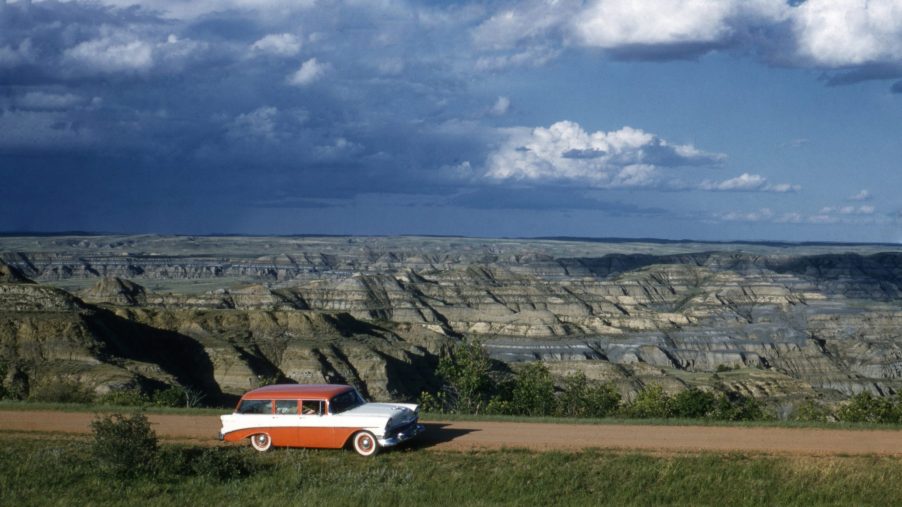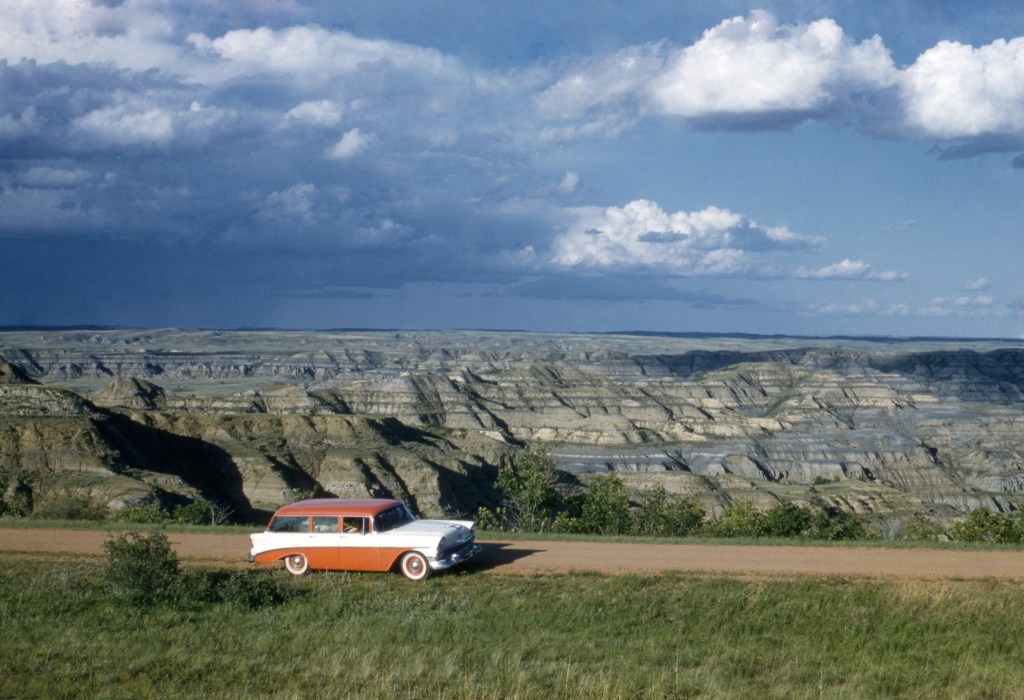
Road Trip Songs and the Classic Cars That Inspired Them
I love road trips, and as long as I’m a writer here, I’ll never keep that a secret. I also feel I have some authority on the topic of driving music, having over 1,100 songs in my library (68 hours in total). So if you’re hitting the road any time soon, whether it’s 10 miles down the road or 1,000 miles across the country, you’ll need to get some music ready. These are some of my favorite road trip songs, and a little bit of history about the classic cars that inspired them.

Pink Cadillac by Bruce Springsteen is excellent for cruising and schmoozing
My love for the song Pink Cadillac is bigger than a Honda. It’s even bigger than a Subaru (most of which have become rather bloated if you ask me). But there’s no getting around one simple fact: this song is all about sex. In fact, the term “pink Cadillac” is a metaphor for female genitalia. After all, what kind of party do you think they’re having in the back of that pink Cadillac?
Sorry you had to learn about that from me. But don’t worry, my perception of the song shifted when I first realized that too.
However, as to not spoil any more innocence, let’s assume Springsteen is talking about cars. On vinyl record covers, the pink Cadillac in question is a 1959 Cadillac Coupe DeVille. However, any pink Cadillac you see from that year didn’t start out as pink. The only year GM sold a Cadillac Coupe DeVille with a pink hue was in 1956, riding off the coattails of Elvis, who had just bought a blue 1955 Coupe DeVille and repainted it pink.
But hey, at 18.75 feet long, there’s a whole lot to love about the pink Cadillac Springsteen is talking about.
Maybelline by Chuck Berry is a drag racing metaphor with a Coupe DeVille and a V8 Ford
Romance and cars seem to go hand in hand. Though, unlike Pink Cadillac, where the two are enjoying themselves, Maybelline is all about a man who can’t keep up with his cheating girlfriend, Maybelline. With such a catchy, upbeat rhythm, that’s not exactly the message you’d expect.
But let’s get nerdy and talk about the cars. All we know is that the man in the song is driving a “V8 Ford” while the woman is driving a Cadillac Coupe DeVille. So the first question is simple: what’s the man driving?
Well, the song was released in 1956. And it just so happens that Ford released a new engine two years prior: the V8 Y-block. It came in four different sizes, a 239 cubic inch that made 130 hp, a 256 cubic inch that made 161 horsepower, a 272 cubic inch that made 173 horsepower by 1956 (it originally only had 162 hp in 1955), and finally, a 292 that made 200 horsepower at its peak.
The only lyrical clue we get as to the dimensions of the man’s engine is that “nothin’ will outrun my V-8 Ford.” With that kind of confidence, I’m going to assume the man opted for the big 292 engine, though Chuck could be rolling in his grave over that assumption.
Now, here’s where things get tricky. This particular engine was also nicknamed the Thunderbird V8. And by 1956, all Fords had that engine as an available option. That doesn’t help narrow it down, so let’s take a step back and look at the Cadillac Coupe DeVille.

The name “Coupe DeVille” wasn’t actually the name of Maybelline’s 56 Cadillac. It was actually called a Series 62, and features either a 331 cubic inch V8 or a 365 cubic inch V8. That displacement alone means, no matter what the man in the song is driving, Maybelline can outrun it.
The only clue left is one lyric, where Chuck Berry sings “The Cadillac pulled up at 104. The Ford got hot and wouldn’t do no more.” This implies the top speed of the Ford is 104. And while every Ford model from 1956 had the Thunderbird V8 engine, this rules out the Thunderbird as the car in question, as that had a top speed of 113.
The car that perfectly fits the bill, however, is the 1956 Ford Fairlane, specifically the four-door model, which was heavy enough where the top speed was lowered to, you guessed it, 104 miles an hour.
Wow… I fell down a bit of a rabbit hole there. But now we know that the man was most likely chasing after Maybelline in a 1956 Ford Fairlane with a 292 cubic inch motor, and a top speed of 104. The more you know.
My Hooptie by Sir Mix-A-Lot is a song about a shitbox
Whether I’m on a road trip or not, I can’t help but sing along when this song plays. Sir Mix-A-Lot is as much a car geek like the rest of them, but this particular song strikes a chord with me. There are plenty of songs about classic cars, but not enough about rusty piles of junk, and this 69 Buick might be the king of jalopies.
With mismatched tires and smoke blowing out the exhaust, Mix-A-Lot has to roll is 1969 Buick Electra 255 cause his Benz is in the shop. This was much easier to figure out since you could just watch the music video, so no lyrical assumptions were necessary.
Though, in case you were curious, this deuce is packing heat: 360 horsepower from a 430 cubic inch V8 engine. And back when the car was first built, it wasn’t exactly cheap. In 1969, a Buick Electra cost $4,300 new, which is about $32,000 in today’s money. But My Hooptie was recorded 20 years later, in 1989. That’s plenty of time for rust to accumulate.
Though, there’s one factual inaccuracy in the song, despite throwing car terms around left and right (which I loved). Sir Mix-A-Lot claims “it’s a three-ton monster, econobox stomper.” And while the latter may be true, the 1969 Buick Electra actually only weighed 4,300 lbs. So just a little over two tons. But other than that, this might be my favorite song to just bounce along with.
Rusty Old American Dream by David Wilcox is a ballad to classic cars
While all of these songs have been centered around one, or a couple of classic cars, this song is a tribute to all classic cars. It gives them a soul and a voice, though the particular classic car David Wilcox sings about has seen better days. Sitting with a for sale sign on the side of the road, this automobile longs for a new owner. One who will polish the chrome, and keep it running until it can’t pass state inspection anymore.
But because I’m stubborn, you’d better strap in, because I’m going on another deep dive to try and figure out what this car might be. From the lyrics, we get a couple of clues, the biggest one being that it “rolled off the line in Detroit back in 1958.” So not only is it a car from 1958 but it was assembled in Detroit.
On top of that, this car has tailfins and rolled off the dealership floor just after it was built. That implies it was popular, and the best-selling car of that year was the Ford Thunderbird. And while other automobiles had larger tailfins, such as the AMC Ambassador of the same year, it makes some sense that the Thunderbird is the car in question.
But one key lyric leads me to believe that the Ford Thunderbird wasn’t the car in question: “but I’m weakened underneath me where my frame is rusted thin.” Rather than a body-on-frame design, where the chassis is under the car, the second generation Ford Thunderbird was a unibody, meaning it didn’t really have a frame underneath to rust.
The car also wasn’t assembled in Detroit Michigan, but rather Wixom Michigan. And while that’s only half an hour away, and still considered the Detroit area, it’s an important little detail.
For these reasons, I think the rusty old American dream in question was a Dodge Coronet. In 1958, their entire line of cars had a shakeup, with new styles built on the platforms of DeSotos. But the Coronet had implanted itself as the company’s base model car and sold far more units than the Dodge Charger did when new (170,000 verse 37,000). They also boasted bigger tailfins than the Thunderbird and had body-on-frame designs. But most importantly, these cars were built right in Detroit.
Though, another car with massive tailfins that was built in Detriot in 1958 was the Packard Hawk. But I know this isn’t the car in the song because, unlike the Thunderbird or the new Dodge lineup, the Packard was a flop. And that same year, their 3.5 million square foot factory in Detroit closed down.
This one is more of a stab in the dark, so I don’t have as much confidence in my decision despite the fact that I’ve been digging around for the better part of an hour. And by now, you’re probably sick of hearing my crack-pipe theories based on educated guesses, so let’s move on.
Silver Thunderbird by Marc Chon is a beautiful tribute to the artist’s father
We’ve strayed from road trip music to meaningful music, but I feel that the best songs tell a story or embrace a feeling, which most of the entries on this list do. This one, however, does both. Marc Chon pours his heart out over the piano, describing what it feels like to not know your father even after he’s passed away. The only thing he knew for certain, is that his dad cherished his Silver Thunderbird.
In the music video, the Thunderbird in question is a third-generation, meaning anywhere from 1961 to 1963. And if you listen closely, you can even hear the 380 cubic inch V8 gurgling in the background. Over three years, sales of the Thunderbird were even hotter than those of the second generation, selling over 70,000 units in the first year alone, and over 200,000 over the car’s entire production run.
I could go on forever when it comes to automotive songs, even ones that aren’t strictly about classic cars. Love Shack by The B52s is all about a big 1964 or 1965 Chrysler 300 L convertible (which couldn’t fit 20 people, but it is as big as a whale). Convoy by C. W. McCall is all about a Kenworth pulling longs alongside a cab-over Pete with a reefer on. Or, in English, a cab-over-engine Peterbilt refrigerator truck. Even one of my favorite songs, Still Rock And Roll To Me by Billy Joel, mentions a true baby blue Lincoln Continental Mark V.
But at least now you have a few more classic car-adjacent songs to add to your road trip playlist. I hope they serve you well as you chow down the miles, and soak up the memories.


